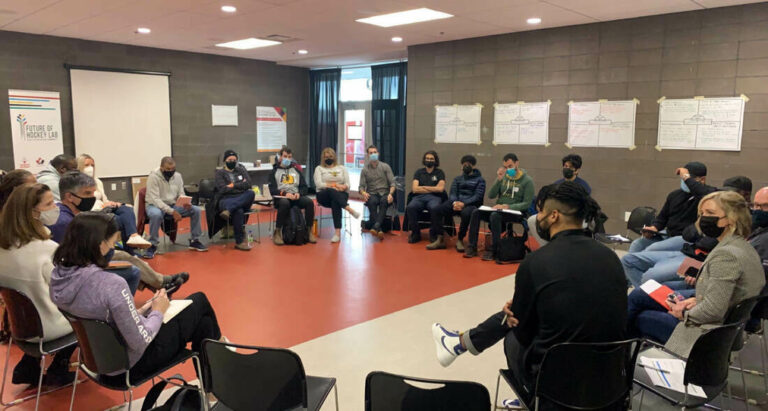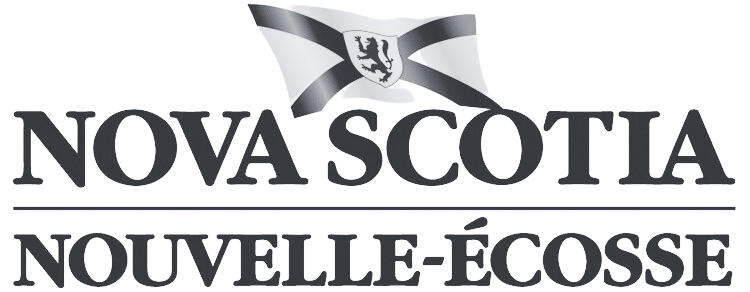Written by Denise Withers
"This isn't going to work," they both muttered, then laughed at the jinx. It was a tough insight for Leonard Roberts and Matt English to accept. But in their gut, they knew it was right.
It had only been a couple of months since they'd joined the Future of Hockey Lab.
And they were pretty excited about their idea to build a "hockey hub" that would make it easier for people to get started in hockey. The online hub would do a number of things: pull in information from all the different programs and resources available, curate the information according to what users need, and act as a kind of wizard to guide them through the process. It's something the game of hockey desperately needs to be more accessible to newcomers – something Leonard knows from experience.
Originally from the Bahamas and now living in Halifax, hockey wasn't part of his life – until his 9-year-old son wanted to start playing. Then he discovered just how obtuse the hockey system can be. With the help of others, he figured things out. And two years later, he’s hooked.
"In terms of falling in love with it – it's less about the sport and more about the community – getting to know the families and camaraderie that comes along with it. Growing up, I primarily played basketball, where there's not a lot of family involvement. You have your buddies that you play with, but mom and dad and sister and brother don't come to watch you play. But when people show up for hockey, the whole family's there."
Leonard believes that millions more newcomers could fall in love with the game too – if they could just figure out how to get started. So he joined the Lab to see what he could do.
Making barriers visible
Though access for newcomers is a common theme throughout the Lab's research and projects, it was a relatively new concept for Matt, who had literally skated through a competitive career with zero barriers. He started at age four, went through minor hockey, played at university and is now in his first year of coaching. Looking back, Matt's grateful for his experience and recognizes the incredible value hockey has brought to his life.
"My best friends today are the guys that I started playing hockey with when I was seven or eight years old. I had the opportunity to travel all across Canada to play in events. Hockey brought me great skills and character traits like resiliency, determination and leadership. And then moving on to university, it helped pay for my schooling."
Yet he knew it wasn't like that for everyone - and joined the Lab as a way to give back.
We kind of did a round table at the first session where everybody shared their personal experiences with hockey. And it was really eye-opening. It really highlighted how privileged I was going through it because I don't remember facing the barriers they saw, whether that was in women's hockey or rural communities or people with disabilities or minorities that were just getting started. When you don't live those experiences, it's hard to always see them, so it’s important to listen.
Finding the right idea to prototype can be tough
After exploring the background research the Lab provided and brainstorming with the team, Matt and Leonard cooked up the idea of the "Hockey Hub" to tackle the access issue. The pair quickly found out that, although lots of programs and supports already exist, they're hard to find. And most newcomers don't even know what they're looking for. So they spent the next two months exploring different ways to find, curate, simplify, translate and market that information for newcomers to hockey.
But they struggled. Their idea was too big, too technical and too hard to build and test within the Lab's 6-month timeframe.
"We both have some experience in the world of technology," Matt explains. "So we knew that this was actually a technology product, not a social innovation one. And we were thinking about ways to test the idea using really simple wireframe mock-ups of what the webpage could look like in a perfect world, trying to scale down the problem as much as we could. But as we were going through that process, we decided that it was going to require a fair amount of effort to get to a stage where we felt like we could really run some good pilot tests. So we started to think about a pivot."
The path to innovation is rarely linear
Then, they discovered synthetic ice. In sync again, they immediately saw its potential to transform the game in countless ways, by making it more accessible and visible.
Synthetic ice isn't new, but it has improved significantly in recent years. It's basically just plastic sheets that snap together to form a realistic ice surface that can last up to ten years, and operate at a fraction of the cost. It's 90% as fast as real ice, and can be used to practise all skills – even hockey stops. But unlike real ice, you can put it anywhere – it doesn't depend on temperature. Plus it's made of sustainable materials that could help address concerns about hockey and climate change. Today's synthetic ice is so realistic that some NHL players even have it in the basements of their homes. In short, it could be a game-changer.
As Matt explains, "We noticed that a lot of sports that are low cost and tend to have really good communities are sports like baseball, soccer and softball, where folks can come out to a court or somewhere outdoors in the summer and just kind of hang out as a group. It's a fun environment, not a hard-core sports environment that's loud, cold, noisy and smells bad. So we were thinking if we had some synthetic ice in the summer, we could bring the sport to people who don't play hockey – and create a place for the community to just come out and watch."
Leonard and Matt could see that the possibilities were endless. They could set up "pop-up" rinks in parks and gyms to let people try hockey out anywhere, any time of year. Over the long term, they could even build a network of synthetic rinks that could also serve as information points - meeting the needs of their original hockey hub idea.
The more they learned, the more excited Matt and Leonard became. Then, they realized that it was just too late in this phase of the Lab's work to test it out. But that's not going to stop them. They're hoping to be able to prototype their idea this summer, by picking a community and just doing it.
“Though the concept of a synthetic rink seems tougher to test than software, which is what Leonard and I are both used to, we have a few ideas we’re considering trying out,” Matt explains. “We might start with something simple like an outdoor ball hockey event, just to gauge interest. Then could look at building a small synthetic rink, getting some donated skates and inviting the community to try it out in a park somewhere.”
Although these kinds of ups and downs are an expected part of the innovation journey, Leonard and Matt still experienced a lot of frustration from what they saw as their lack of progress along the way. When the lab reconvened after a break because of Covid, the pair thought that all the other teams would be way ahead of them. But, they were not alone. And they've come to realize that they just need to trust the process. Opportunities can appear from anywhere to make unexpected connections and develop new ideas.

Think smaller. Go faster.
Plus, it's been a great learning experience for them both – not just about the hockey system, but also about innovation practices, as they've had the chance to work with some of the top social innovation experts in Canada.
As Leonard recalls, "I think the biggest thing I got from Jerry (Koh) was 'That's too big and that's too slow. Think smaller, go faster. Just iterate. Find a way to get moving. Because if you try to check too many boxes, you're going to never get it done.’ And I think that was the first time I really understood how fast we should be moving and how small a scale we should be building at."
Matt adds, "He walked us through the process they use at the MaRS Solutions Lab, which was really eye-opening and educational. Just the way that he would think through problems and then simplify, 'Hey, if you guys are trying to solve this, then let's backtrack to discover the small steps that would actually make that happen? And test each one along the way.' So that was really helpful."
Over time, Leonard also realized they were learning a great deal from others in the Lab. "There were others having struggles, but there was also some encouragement to see how other projects in the Lab were starting to make little changes with big impact. I could see teams starting to piggyback off each other. So it was an opportunity to learn from others and not have to figure it all out yourself."
Change starts with empathy and imagination
Perhaps most importantly, they also developed a deeper understanding of the real challenges of trying to advance diversity, equity and inclusion, as they heard some pretty shocking stories firsthand.
"I'll be honest," Leonard sighs. "I saw a part of hockey that I didn't like. And I think I was made more aware of it than I had ever been. I heard the stories the first day. Then, I showed up at hockey the next day with my son and some of it suddenly became blatantly obvious. This Lab opened my eyes to some of the problems that are in hockey for better or for worse."
Despite the challenges of their first Lab experience, both Leonard and Matt are keen to keep going to make a difference.
"I love to think that our project could create an opportunity for a kid to sign up for hockey and move up through the ranks and become a rising star who might otherwise not have had an opportunity to try hockey,"
Matt shares. "Just taking the initiative to launch the Future of Hockey Lab is such a huge step forward. And I hope it has a ripple effect where it catches fire because ultimately we're going to need thousands of ideas to find the few ideas that are really going to change the game. So we need to get more people involved."
Leonard agrees. "People say that my son started too late to ever "make it" in hockey. So the question is, could we have created that love for him a little bit earlier – if something like this had been up the park where he could have seen all these other little kids doing it and tried it? Because if you think about hockey right now, the love of hockey and what hockey has to offer is hidden in that dome. And if you're not in that dome, you don't get to experience it. It's almost like a secret society. Do you know the secret handshake to get into the Hawks?
So I really want to be a part of the change that needs to be brought about. Because as a father, I look at my son and I worry – am I setting him up to fall in love with the sport that won't love him back?"



